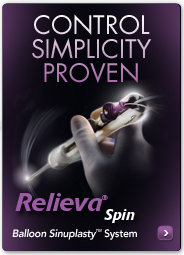By Daniel W Todd, MD, FACS
 Sinusitis is a huge problem, affecting up to 15% of the population at some point. Up to 24 million Americans are afflicted annually and studies show a huge detriment in quality of life and work place productivity. 20 million office visits and over 3 billion dollars are year are attributed to sinus infections.
Sinusitis is a huge problem, affecting up to 15% of the population at some point. Up to 24 million Americans are afflicted annually and studies show a huge detriment in quality of life and work place productivity. 20 million office visits and over 3 billion dollars are year are attributed to sinus infections.Treatment is generally medical and conservative. Antibiotics, steroids, decongestants, mucolytics and time resolve the vast majority of them. Allergy evaluation and possible desensitization (allergy shots or drops) are helpful in avoiding chronic inflammation and resultant infections in some. Some unfortunate individuals are subject to persistent chronic or recurrent infections despite maximal medical and allergy treatment. In these patients, surgical intervention has proven helpful.
Surgical intervention of the nose and sinuses can have any of three objectives. Improving the nasal airway, improving the appearance of the nose, and opening the sinuses into the nose. If there are multiple objectives, general anesthesia is a practical necessity. Anesthesia and facility fees for surgery account for the vast majority of the costs. Altering the anatomy (correcting the septum, reducing the turbinates) is real surgery and requires post operative recovery.
If the sole objective is to open the sinuses, then new technology allows select patients to avoid the operating room. This is extremely advantageous from a cost and recovery standpoint. It essentially takes a major surgical procedure and turns it to something similar to an involved dental procedure. Patients can potentially return to full activity immediately, some even driving themselves home.
I have seen this be tremendously effective in select patients, avoiding a trip to the OR—which saves them money and time off work.
Dilating the sinuses with light wires and balloons is a technique I have been using in the operating room for more than 7 years. Taking this technique into the clinic is not too much of a stretch. The majority of the effort is in achieving adequate local anesthesia. We often take up to 30 minutes applying topical numbing medications before starting. Patients are tolerating it remarkably well and really appreciate not having to go to the hospital. I have seen several patients get excellent results with this limited intervention.
All in all, I see it as an additional tool in our armentarium. We pride ourselves as being able to offer any and all therapies for our patient’s sinonasal complaints including cosmetics and allergy issues.